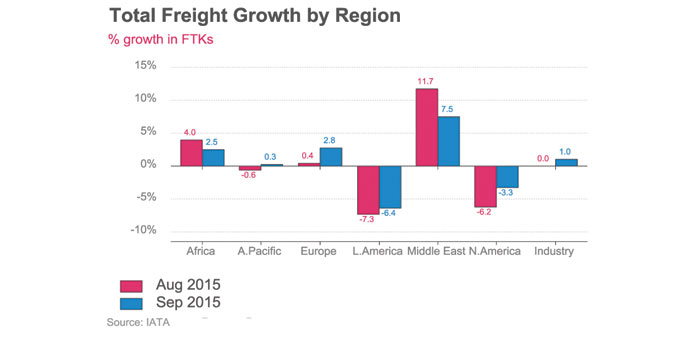Continued growth in air freight carried by Middle Eastern airlines (up 7.5% in September year-on-year) has helped offset weakness in other regions, IATA has said in its latest air freight market analysis.
Major economies in the Middle East, including Saudi Arabia and the UAE, have seen slowdowns in non-oil sectors, but the rates of growth remain robust and this should help sustain solid growth in air freight demand for local carriers, it said.
Freight volumes were up slightly in September, with freight tonne kilometres (FTKs) 1.0% higher compared to a year ago, the International Air Transport Association said.
This was a small improvement on August, when volumes were broadly stable year-to-year. However, the increase is narrowly based and trade and business confidence remain weak in key regions.
FTKs expanded by 0.7% in September compared to August. But this expansion in volumes was carried mostly by airlines in advanced economies, where business conditions and trade activity have shown some improvement.
Airlines in the Asia Pacific, which carry the greatest share of global air cargo, continue to experience weakness.
Carriers in Europe recorded a rise of 2.8% in September, year-on-year. This is well above the trend in 2015, which has been flat year-to-date.
Recent improvements in eurozone manufacturing business activity could finally be starting to support air freight demand. In addition, some improvements in trade activity to/from Central and Eastern Europe is helping as well.
Continued growth in freight carried by Middle Eastern airlines (up 7.5%) in September year-on-year has helped offset weakness in other regions, IATA said.
Asia Pacific carriers recorded an increase of just 0.3% in September. Conditions in the region remain fragile with China and other key export economies, including Korea and Chinese Taipei, continuing to see disappointing trade growth.
Despite the rise in demand in September, load factors showed no improvement and remain at lows not seen since 2009. In addition to recent weakness in cargo demand, there has been continued capacity expansion, partly from growth in the passenger business, and this has placed downward pressure on cargo load factors.
Some of the conditions that led to the decline in world trade this year – a combination of weaker than expected global economic growth, particularly in emerging markets, as well as shifts toward the domestic market in China – are persisting.
The September data suggests that improvements in some regions could counter further declines in air cargo demand. But this is narrowly-based and the demand backdrop for air cargo remains fragile, IATA said.



